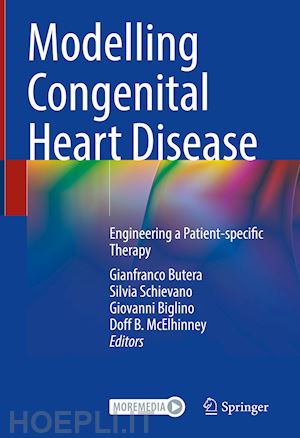
Questo prodotto usufruisce delle SPEDIZIONI GRATIS
selezionando l'opzione Corriere Veloce in fase di ordine.
Pagabile anche con Carta della cultura giovani e del merito, 18App Bonus Cultura e Carta del Docente
This book combines medicinal and engineering knowledge to present engineering modelling applications (mainly computational, but also experimental) in the context of facilitating a patient-centred approach to treating congenital heart disease (CHD). After introducing the basic concepts of engineering tools, it discusses modelling and the applications of engineering techniques (e.g. computational fluid dynamics, fluid-structure interaction, structural simulations, virtual surgery, advanced image analysis, 3D printing) in specific congenital heart diseases. It also offers a number of clinical case studies describing the applications in real-life clinical practice. The final section focuses on the importance of surgical training, counselling and patient communication.
Considering the unique anatomical arrangement pre/post repair in CHD, as well as the different surgical strategy and device options (e.g. stents) for interventions, a patient-specific approach is certainly warranted in this area of medicine, and engineering is helping improve our understanding of individual patients and their particular anatomy and physiology.
To reinforce the idea of a necessary dialogue between clinicians and engineers, this book has not only been edited by two cardiologists and two bioengineers, but each chapter has been written by a clinician and an engineer, incorporating both voices in the description of state-of-the-art models for different CHDs.
Gianfranco Butera is Chief of the Department of Interventional Congenital Cardiology at Bambin Gesù Hospital IRCCS, Rome, Italy. He is Senior lecturer at King's College University London. He has been Lead Consultant of the Department of Congenital Interventional Cardiology at St Thomas/Evelina Hospital in London. He has served as Chairman of the Interventional Cardiology Working Group of the AEPC and has been Visiting Professor at various universities including Harvard, Bordeaux, Cincinnati and Padova. His clinical and research interests are focused on interventional cardiology in children and adults with congenital heart disease. He has authored more than 230 papers in peer-reviewed journals and has edited books on interventional and fetal cardiology.
Silvia Schievano is Professor of Biomedical Engineering at University College London, UK. She graduated from Politecnico of Milan, Italy, and pursued her PhD degree in clinical cardiovascular engineering at Great Ormond Street Hospital for Children, UK. Her main research activities are in translational engineering for clinical practice, focusing on patient specific assessment of complex congenital heart disease cases, statistical shape modelling and population analyses, and computational simulations to support design of new transcatheter valve implantation devices.
Giovanni Biglino is a biomedical engineer and currently Senior Lecturer in Biostatistics at the Bristol Heart Institute (Bristol Medical School, UK). After a degree in Bioengineering at Imperial College London and a PhD in cardiovascular mechanics at the Brunel Institute for Bioengineering, he carried out research at Great Ormond Street Hospital and University College London, and completed the Global Clinical Scholars Research Training programme at Harvard Medical School, Boston, USA. His main research interests are cardiovascular modelling, translational research in congenital heart disease and medical statistics. He is a Future Leader in Innovation Enterprise and Research with the UK Academy of Medical Sciences.
Doff B. McElhinney, MD, is a pediatric and adult congenital interventional cardiologist who is a Professor of Cardiothoracic Surgery and Pediatrics (Cardiology) at Stanford University. He is Director of the Clinical and Translational Research Program and Medical Director of the Pulmonary Artery Reconstruction Program at the Lucile Packard Children’s Hospital Stanford. After a residency in Pediatrics at The Children's Hospital of Philadelphia, PA, US, he completed pediatric and interventional cardiology fellowships at Children’s Hospital in Boston, MA, US. He served on the faculty at Children’s Hospital in Boston for 6 years, then assumed the role of Director of Interventional Cardiology for Structural and Congenital Heart Disease at New York University, where he served as a Professor of Pediatrics, Medicine, and Cardiothoracic Surgery. He has been at Stanford since 2014.











Il sito utilizza cookie ed altri strumenti di tracciamento che raccolgono informazioni dal dispositivo dell’utente. Oltre ai cookie tecnici ed analitici aggregati, strettamente necessari per il funzionamento di questo sito web, previo consenso dell’utente possono essere installati cookie di profilazione e marketing e cookie dei social media. Cliccando su “Accetto tutti i cookie” saranno attivate tutte le categorie di cookie. Per accettare solo deterninate categorie di cookie, cliccare invece su “Impostazioni cookie”. Chiudendo il banner o continuando a navigare saranno installati solo cookie tecnici. Per maggiori dettagli, consultare la Cookie Policy.